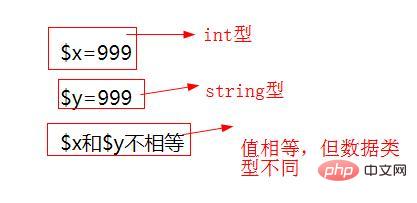What is the meaning of '==' symbol in php
In PHP, the "==" symbol is a comparison operator that can compare whether two operands are equal. The syntax is "operand 1 == operand 2". The "==" operator compares and tests whether the variable on the left (expression or constant) has the same value as the variable on the right (expression or constant); it only compares the values of the variables, not the data types. If the two values are the same, it returns a true value; if the two values are not the same, it returns a false value.

The operating environment of this tutorial: windows7 system, PHP8 version, DELL G3 computer
In php, the "==" symbol Is a comparison operator that can compare whether two operands are equal.
Equality (==) operator
The equation (==) operator compares and tests the left Whether a variable (expression or constant) has the same value as the variable (expression or constant) to the right; the comparison performed by this operator is loose.
If the two values are the same (it only compares the value of the variable, not the data type), it returns a true value; if the two values are not the same, it returns a false value.
Note: The equality (==) operator and the assignment (=) operator are different. The assignment (=) operator changes the variable on the left, assigning the variable on the right to the variable on the left, while the equality (==) operator tests for equality and returns true or false depending on the comparison.
<?php
header("content-type:text/html;charset=utf-8");
// 给变量赋整数值
$x = 999;
echo '$x='.$x."<br>";
// 给变量赋字符串值
$y = '999';
echo '$y='.$y."<br>";
//比较$x 和$y
if ($x == $y)
echo '$x和$y的值相等';
else
echo '$x和$y的值不相等';
?>
In the above example, because the equality (==) operator only compares the values of variables, the values of $x and $y are equal, so directly The statement in the if is executed, and the else statement is not executed.
Extended knowledge: Identity (===) operator
If you want to compare whether the values are equal and also want to compare data To determine whether they are equal, you need to use the "===" operator.
The identity (===) operator performs a strict comparison between given variables or values; it compares and sees if two variables (expressions or constants) have equal values and have the same data type , i.e. both are strings or both are integers, etc.
This operator returns true if two variables (expressions or constants) contain the same value and the same data type, otherwise it returns false.
<?php
header("content-type:text/html;charset=utf-8");
// 给变量赋整数值
$x = 999;
echo '$x='.$x."<br>";
// 给变量赋字符串值
$y = '999';
echo '$y='.$y."<br>";
//比较$x 和$y
if ($x === $y)
echo '$x和$y相等';
else
echo '$x和$y不相等';
?>
In the above example, the values of $x and $y are equal but the data types are different, so false is returned and the else part is executed.
PHP Comparison Operators
| Example | Name | Description |
|---|---|---|
| $a == $b | is equal to | If the values of $a and $b are equal after type conversion, TRUE is returned, otherwise FALSE is returned |
| $a === $b | Congruent | Returns TRUE if $a and $b are not only equal in value, but also have equal types of their values, Otherwise return FALSE |
| $a != $b | is not equal to | If the value of $a is not equal to the value of $b after type conversion, then Returns TRUE, otherwise returns FALSE |
| is not equal to | is the same as !=, if $a is after type conversion The value of is not equal to the value of $b, then TRUE is returned, otherwise FALSE | |
| is not equal | If $ If the value of a is not equal to the value of $b, or the types of their values are different, TRUE is returned, otherwise FALSE is returned | |
| 小与 | If the value of $a is less than the value of $b, return TRUE, otherwise return FALSE | |
| is greater than | If the value of $a is greater than the value of $b, return TRUE, otherwise return FALSE | ##$a <= $b |
| If the value of $a is less than or equal to the value of $b, return TRUE, otherwise return FALSE | ##$a >= $b | |
| If the value of $a is greater than or equal to the value of $b, return TRUE, otherwise return FALSE | $a <=> $b | |
| When $a is less than, equal to, or greater than $b, return an integer value less than, equal to, or greater than 0 respectively. PHP7 starts to provide. | $a ?? $b ?? $c | |
| The first one from left to right exists and Operands that are not NULL. If neither is defined and is not NULL, NULL is returned. Available starting with PHP7. | Recommended study: " |
The above is the detailed content of What is the meaning of '==' symbol in php. For more information, please follow other related articles on the PHP Chinese website!

Hot AI Tools

Undresser.AI Undress
AI-powered app for creating realistic nude photos

AI Clothes Remover
Online AI tool for removing clothes from photos.

Undress AI Tool
Undress images for free

Clothoff.io
AI clothes remover

Video Face Swap
Swap faces in any video effortlessly with our completely free AI face swap tool!

Hot Article

Hot Tools

Notepad++7.3.1
Easy-to-use and free code editor

SublimeText3 Chinese version
Chinese version, very easy to use

Zend Studio 13.0.1
Powerful PHP integrated development environment

Dreamweaver CS6
Visual web development tools

SublimeText3 Mac version
God-level code editing software (SublimeText3)

Hot Topics
 1657
1657
 14
14
 1415
1415
 52
52
 1309
1309
 25
25
 1257
1257
 29
29
 1229
1229
 24
24
 PHP 8.4 Installation and Upgrade guide for Ubuntu and Debian
Dec 24, 2024 pm 04:42 PM
PHP 8.4 Installation and Upgrade guide for Ubuntu and Debian
Dec 24, 2024 pm 04:42 PM
PHP 8.4 brings several new features, security improvements, and performance improvements with healthy amounts of feature deprecations and removals. This guide explains how to install PHP 8.4 or upgrade to PHP 8.4 on Ubuntu, Debian, or their derivati
 Explain JSON Web Tokens (JWT) and their use case in PHP APIs.
Apr 05, 2025 am 12:04 AM
Explain JSON Web Tokens (JWT) and their use case in PHP APIs.
Apr 05, 2025 am 12:04 AM
JWT is an open standard based on JSON, used to securely transmit information between parties, mainly for identity authentication and information exchange. 1. JWT consists of three parts: Header, Payload and Signature. 2. The working principle of JWT includes three steps: generating JWT, verifying JWT and parsing Payload. 3. When using JWT for authentication in PHP, JWT can be generated and verified, and user role and permission information can be included in advanced usage. 4. Common errors include signature verification failure, token expiration, and payload oversized. Debugging skills include using debugging tools and logging. 5. Performance optimization and best practices include using appropriate signature algorithms, setting validity periods reasonably,
 How do you parse and process HTML/XML in PHP?
Feb 07, 2025 am 11:57 AM
How do you parse and process HTML/XML in PHP?
Feb 07, 2025 am 11:57 AM
This tutorial demonstrates how to efficiently process XML documents using PHP. XML (eXtensible Markup Language) is a versatile text-based markup language designed for both human readability and machine parsing. It's commonly used for data storage an
 Explain late static binding in PHP (static::).
Apr 03, 2025 am 12:04 AM
Explain late static binding in PHP (static::).
Apr 03, 2025 am 12:04 AM
Static binding (static::) implements late static binding (LSB) in PHP, allowing calling classes to be referenced in static contexts rather than defining classes. 1) The parsing process is performed at runtime, 2) Look up the call class in the inheritance relationship, 3) It may bring performance overhead.
 PHP Program to Count Vowels in a String
Feb 07, 2025 pm 12:12 PM
PHP Program to Count Vowels in a String
Feb 07, 2025 pm 12:12 PM
A string is a sequence of characters, including letters, numbers, and symbols. This tutorial will learn how to calculate the number of vowels in a given string in PHP using different methods. The vowels in English are a, e, i, o, u, and they can be uppercase or lowercase. What is a vowel? Vowels are alphabetic characters that represent a specific pronunciation. There are five vowels in English, including uppercase and lowercase: a, e, i, o, u Example 1 Input: String = "Tutorialspoint" Output: 6 explain The vowels in the string "Tutorialspoint" are u, o, i, a, o, i. There are 6 yuan in total
 What are PHP magic methods (__construct, __destruct, __call, __get, __set, etc.) and provide use cases?
Apr 03, 2025 am 12:03 AM
What are PHP magic methods (__construct, __destruct, __call, __get, __set, etc.) and provide use cases?
Apr 03, 2025 am 12:03 AM
What are the magic methods of PHP? PHP's magic methods include: 1.\_\_construct, used to initialize objects; 2.\_\_destruct, used to clean up resources; 3.\_\_call, handle non-existent method calls; 4.\_\_get, implement dynamic attribute access; 5.\_\_set, implement dynamic attribute settings. These methods are automatically called in certain situations, improving code flexibility and efficiency.
 PHP and Python: Comparing Two Popular Programming Languages
Apr 14, 2025 am 12:13 AM
PHP and Python: Comparing Two Popular Programming Languages
Apr 14, 2025 am 12:13 AM
PHP and Python each have their own advantages, and choose according to project requirements. 1.PHP is suitable for web development, especially for rapid development and maintenance of websites. 2. Python is suitable for data science, machine learning and artificial intelligence, with concise syntax and suitable for beginners.
 PHP: A Key Language for Web Development
Apr 13, 2025 am 12:08 AM
PHP: A Key Language for Web Development
Apr 13, 2025 am 12:08 AM
PHP is a scripting language widely used on the server side, especially suitable for web development. 1.PHP can embed HTML, process HTTP requests and responses, and supports a variety of databases. 2.PHP is used to generate dynamic web content, process form data, access databases, etc., with strong community support and open source resources. 3. PHP is an interpreted language, and the execution process includes lexical analysis, grammatical analysis, compilation and execution. 4.PHP can be combined with MySQL for advanced applications such as user registration systems. 5. When debugging PHP, you can use functions such as error_reporting() and var_dump(). 6. Optimize PHP code to use caching mechanisms, optimize database queries and use built-in functions. 7




